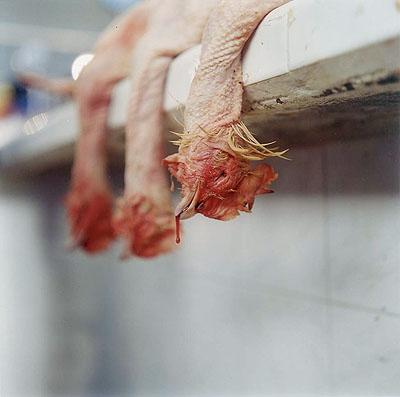
Untitled (from the series "Aila"), 2004
c-print, 101 x 101 cm, ed. 6
Rinko Kawauchi »
Exhibition: 22 Sep 2006 – 30 Mar 2007

Galerie Priska Pasquer
Konrad-Adenauer-Ufer 83
50668 Köln
+49 (0)221-9526313
RINKO KAWAUCHI In her native Japan the 34 year old Japanese photographer Rinko Kawauchi has become one of the most celebrated photographers her generation. After appearing in several museum exhibitions and festivals in Europe (among others "Rencontres de la Photographie", Arles; Fondation Cartier, Paris; Huis Marseille, Amsterdam: Photographers' Gallery, London) this exhibition will be the first extensive presentation of the photographer in Germany. Works from the series "Aila" (2004) as well as from the series "the eyes, the ears" (2005) and "Utatane" (2001) will be shown. Rinko Kawauchi's work focuses on ordinary things and everyday situations. Her photographs attain their specific quality through her use of cropping and choice of perspective as well as the subtle use of natural light in combination with often virtually transparent colours. Rinko Kawauchi works in series, which, in the form of open narratives, combine poetry and emotion with representations of mortality and occasional melancholy. The subject of Rinko Kawauchi's best-known work "Aila" (which means "family" in Turkish) is the depiction of the essence of life: animals, plants and people are shown in a sequence assembled by free association, which also includes both birth and death. Rinko Kawauchi's fascination in fleeting beauty, the subjects of creation and destruction, and life and death are communicated in her images. "From the black ocean comes the appearance of light and waves. It helps you imagine birth. I want imagination in the photographs I take. It's like a prologue. You wonder, 'What's going on?' You feel something is going to happen." (Rinko Kawauchi) Biographical Summary: Rinko Kawauchi was born in Shiga in 1972 and became interested in photography while she was studying at Seian Junior College of Art and Design. As is customary with Japanese photographers she began her career as an artist by publishing her work in her own photography books. In the year 2001 she became famous over night in Japan after the simultaneous publication of the three photography books "Hanako" (named after a disabled girl), "Utatane" (siesta) and "Hanabi" (fireworks). In 2002 she received the prestigious "Kimuar Ihei Award" for two of the books. In 2004 she published "Aila" (family), in 2005 "the eyes, the ears" (a book about the senses) and "Cui Cui" (which observes the lives of her grandparents over a period of thirteen years). Further publications by Rinko Kawauchi, which should be mentioned, are the photography books "Every day as a child" accompanying the film "Nobody Knows" by director Kore-Eda, as well as "No War", a collaboration with Yoshitomo Nara about Afghanistan and her recently published diary "Rinko Nikki." To date Rinko Kawauchi has published nine photography books. The exhibition is in cooperation with Antoine de Vilmorin, Paris
Die 34-jährige Japanerin Rinko Kawauchi gehört in ihrem Heimatland mittlerweile zu den wichtigsten Künstlern ihrer Generation. Nach mehreren Museumsaustellungen und Festivalbeteiligungen in Europa (u. a. "Rencontres de la Photographie", Arles; Fondation Cartier, Paris; Huis Marseille, Amsterdam; Photographer's Gallery, London) wird die Fotografin mit dieser Ausstellung erstmals in einem größeren Umfang in Deutschland vorgestellt. Gezeigt werden Arbeiten aus der Serie "Aila" (2004) sowie aus den Serien "the eyes, the ears" (2005) und "Utatane" (2001). Im Zentrum von Rinko Kawauchis Arbeit stehen die gewöhnlichen Dinge und Szenen des Alltags. Durch die Wahl der Ausschnitte und Perspektiven und den subtilen Einsatz von natürlichem Licht in Kombination mit oft beinahe durchscheinenden Farben erhalten die Fotografien ihren besonderen Charakter. Rinko Kawauchi arbeitet in Serien, die in der Form von offenen Erzählungen, Poesie und Emotion mit der Darstellung von Vergänglichkeit und gelegentlicher Melancholie verbinden. Thema von Rinko Kawauchis bekanntester Arbeit, "Aila" ("Familie" auf türkisch), ist die Darstellung der Essenz des Lebens: Tiere, Pflanzen und Menschen werden in einer assoziativ angeordneten Bildfolge gezeigt, wobei auch Geburt und Tod mit eingeschlossen werden. Aus den Fotografien spricht Rinko Kawauchis Faszination für eine flüchtige Schönheit, dem Werden und der Zerstörung, Leben und Tod. "From the black ocean comes the appearance of light and waves. It helps you imagine birth. I want imagination in the photographs I take. It's like a prologue. You wonder, `What's going on?´ You feel something is going to happen." (Rinko Kawauchi) Kurzbiografie: Rinko Kawauchi wurde 1972 in Shiga geboren und begann mit der Fotografie während ihres Studiums am Seian Junior College of Art and Design. Ganz in der Tradition der japanischen Fotografie stehend, begann sie ihre Karriere als Künstlerin mit der Publikation ihrer Arbeiten in eigenen Fotobüchern. 2001 erlangte sie in Japan über Nacht Berühmtheit mit der simultanen Publikation der drei Fotobücher "Hanako" (so der Name eines behinderten Mädchens), "Utatane" (Nickerchen) und "Hanabi" (Feuerwerk). 2002 erhielt sie für zwei der Bücher den angesehen "Kimura Ihei Award". 2004 publizierte sie "Aila" (Familie), 2005 "the eyes, the ears" (ein Buch über die Sinne) und "Cui Cui" (eine Beobachtung des Lebens der Großeltern über einen Zeitraum von dreizehn Jahren). Als weitere Publikationen von Rinko Kawauchi sind die Fotobücher "Every day as a child" zu dem Film "Nobody knows" des Regisseurs Kore-Eda zu nennen, sowie "No War", eine Zusammenarbeit mit Yoshitomo Nara über Afghanistan und ihr kürzlich erschienenes Tagebuch "Rinko Nikki". Insgesamt hat Rinko Kawauchi bis heute neun Fotobücher publiziert.

Untitled (from the series "Aila"), 2004
c-print, 30,5 x 25,4 cm, ed. 6

Untitled (from the series "Utatane"), 2001
c-print, 101 x 101 cm, ed. 6

Untitled (from the series "Cui Cui"), 2005
c-print, 30,5 x 25,4 cm, ed. 6